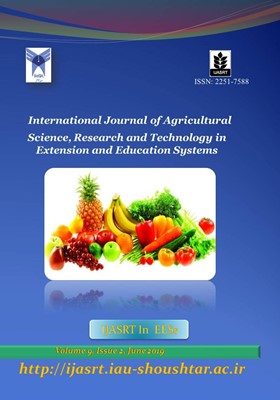Evaluating and Presenting a Model of Competitiveness of Agricultural Products in Khuzestan Using Theme Method
محورهای موضوعی : Agricultural Extension
Seyed Ali Jalali
1
![]() ,
Majid NiliAhmadabadi
2
,
Belqis Bavarsad
3
,
Majid NiliAhmadabadi
2
,
Belqis Bavarsad
3
![]() ,
Saber Mullah Alizadeh Zavardehi
4
,
Saber Mullah Alizadeh Zavardehi
4
1 - Phd student, Department of Management, Masjedsoleiman Branch, Islamic Azad Uniiversity, Masjedsoleiman, Iran
2 - Associate Professor, Vice Chancellor for Education and Research Faculty of Management, Qom University, Qom, Iran
3 - Associate Professor, Chmran of Ahwaz University, Ahwaz,
4 - Assistant professor Department of Industrial Management, MasjedSoleiman Branch,Islamic Azad University, MasjedSoleiman,Iran
کلید واژه: Competitiveness, Agricultural Products, Khuzestan, Semi-structured interview, theme method,
چکیده مقاله :
The purpose of the study was to evaluate and present a model of competitiveness of agricultural products and rank the select cities and products based on the competitiveness advantages in Khuzestan. The study was applied in terms of purpose and descriptive correlation in terms of nature. Data was collected using a semi-structured interview whose reliability was confirmed using the test-retest method. Besides content validity, convergent validity and factor validity were used in the study, where the results confirmed the validity. The population was 15 managers and employees of agricultural departments and managements in Khuzestan selected using the purposive (judgmental) sampling method. The theme method was used to answer the question and analyze the collected results. According to the results, economic factors, cultural, infrastructure, institutional and political factors, rainfall and geographical factors of agriculture, threatening new the new competitors, bargaining power of suppliers, competition between current competitors, and bargaining power of buyers were identified as the aspects of the evaluation model of the competitiveness of agricultural products. The findings indicate that the most competitive cities in terms of the products are Dezful, Shoush, Andimesh, Ahwaz, Shoushtar, Behbahan, and Ramhormoz, respectively. One of the important advantages of the current study is the identification, omission, or replacement of plants with a lower competitive advantage.


